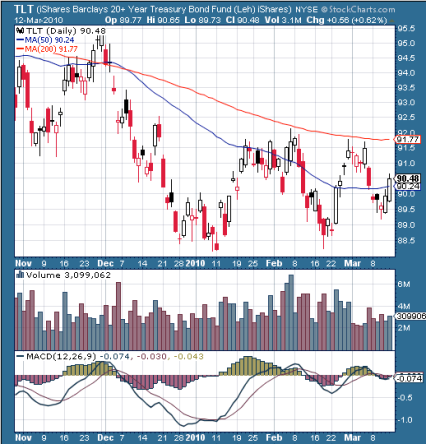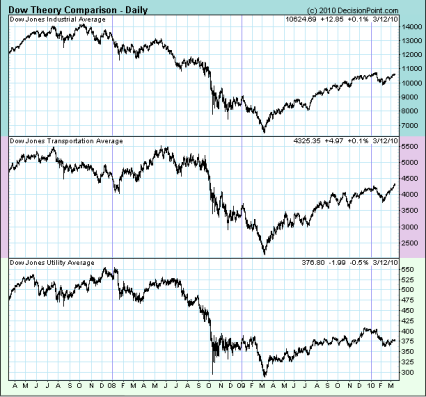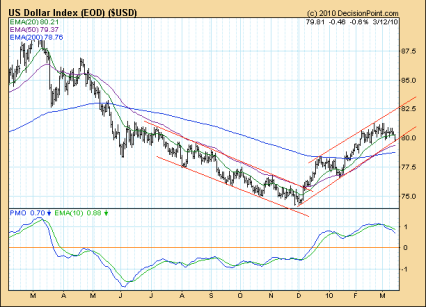SPX- 1149.99
DJIA – 10,624
“No one would blame you for thinking the market is a textbook delusional- paranoid-schizophrenic, not knowing the difference between the real and unreal. And you’d be right. But you’d miss a valuable lesson, misallocation of capital is everywhere and anywhere a fallout of bad government policy.”
-Andy Kessler, The Wall Street Journal, March 10, 2010
The S&P 500 (SPX) surpassed its January high Friday morning, following small cap indexes in a move confirmed by the Market ID (internal dynamics), a persistent advance but not powerful amid light volume aided by minimal selling. I don’t think you want to back up the truck; it’s not that sort of breakout.
When price and time overbalanced in January, the SPX gave a troubling but preliminary indication the primary trend may have shifted. I feared the market was signaling it had already discounted the best that might occur in this cycle. The new recovery high negates that concern, confirming the steady stream of improving economic data. The count for price and time overbalance shifts to the higher hurdle rate set on the January-February decline.

S&P 500 – Daily (Source: StockCharts.com)
The Market Trend Indicator (MTI) continues to signal UPTREND. Each key index is well above its respective 18% weekly exponential average while daily and weekly momentum indicators for each are deep in overbought territory. The SPX’s 18% average is 1112.27 this week and the DJIA’s is 10,367. The New York Advance/Decline line has been positive for 11 consecutive days and is 9,972 net advances above its 18% average.
Peak NYSE net volume is +42.6 on the rally and the peak NASDAQ reading is +44.5. Both are in synch with my trend following indicators, including the MTI, 21-day rule and 3-day swing charts. It’s particularly positive that NYSE net volume with a +26.9 reading is back in sync with a cyclical bull market.
Besides the overbought condition, one fly in the ointment for a top of some proportion in this area, the Dow Industrials have yet to confirm the recovery high by the Dow Transports; the DJIA is 142.46 points shy of its January high. It’s likely a short-term or intermediate-term high unfolds in this area with a trading range high on the list of possible outcomes.
Groups tied to an improving economy dominate the top ten group relative strength list. Furnishings were strong enough over the past month to climb onto the list as well as three other groups in the Consumer Goods sector (Automobiles, Consumer Electronics, Recreational Products). Rounding out the list are two groups in Consumer Services (Recreational Services, Recreational Services), two in Basic Materials (Steel, Coal) and one each in the Financial sector (Mortgage Finance) and Technology (Electronic Office Equipment). Utilities are among the weakest. It remains a contrary market with often short-lived group rotation but perhaps that changes on the next section up.
On a local level, new restaurants are starting to open once again in San Francisco. I’m in Orange County this week and more appropriate to Southern California, an industry survey showed the number of cosmetic-surgeries declined for the second consecutive year, down 17% in 2009 to approximately 1.5 million operations. Breast augmentation was the top procedure (311,957) for the second year running, falling only 12% compared to a 17% drop for liposuction procedures (283,735). Nonsurgical injections for wrinkles (Botox, hyaluronic acid fillers, etc) rose slightly to 8.5 million procedures.

30-year Government Bonds – Weekly (Source: DecisionPoint.com)
In other markets, a bit of a disconnect may be setting up between economically-sensitive groups and the long-term government bond market. The 30-year bond auction went well Thursday and long-term government bonds appear poised to rally further in an intermediate-term move contrary to the primary trend. My recommend stop buy points on TLT shorts (a proxy for long-term government bonds) is a few ticks above the February 5 highs (TLT-92.42).

Barclays 20-yr+ Treasury ETF (TLT) – Daily
Dino Kos, managing director equity research at Portales Partners, explained the fundamental rational for a rally in a Financial Times column, “Won’t the Fed’s balance sheet expansion and ‘quantitative easing’ policies generate inflation and thereby degrade the Treasury’s debt? The recovery, while moving in the right direction is weak by historically standards and the ongoing deleveraging process acts as an ongoing headwind on both growth and inflation. Slack in the economy is high and inflationary pressures are likely to stay low.”
The Federal Reserve reported total U.S. household debt declined 1.9% to $13.5 trillion in 2009, the first annual decline since the Fed started keeping records in 1945. The shrinking reflects both deliberate deleveraging and defaults. Subprime defaults are mostly behind us but next up are better credits in trouble due to the poor economy. The Washington Post reported that 5 to 7 million properties are potentially eligible for foreclosure but have yet to be repossessed. Standard & Poor’s estimates it could take 33 months to clear the backlog.
Longer-term, the government has taken up the borrowing slack but I don’t see an easy exit from quantitative easing without consequences. Inflation remains subdued because money velocity (turnover) is near its low. If the U.S. doesn’t inflate its way out of all the debt, how does the cycle play out? The best solution would be growth, increasing tax receipts and easing the deficits. Next on the list are entitlement cuts and higher taxes, difficult to achieve in election years. The worst solution is action forced on politicians during a crisis when financial markets are under duress. Thank goodness for recent stock market action; it’s not ugly yet.
The Federal Reserve is scheduled to end its mortgage-backed security purchases at the end of March. It has already completed $1.2 billion of a $1.25 billion. Easing the quantitative stimulus creates a headwind for the improving economy and that’s a negative at the margin for the dollar. That may have been it for the rally in the U.S. Dollar index. If so, gold should hold here near its 50-day moving average and rising trendline. I would keep stop sell orders under the February 5 low for recent purchases and keep much looser stops (under the September lows, $989.50 2nd London fix) for longer-held positions. The plan is to raise this point if gold starts to rally from this area.
Harmonic Preview:
(High Probability SPX Turning Point or Acceleration Days)
March 15 (Monday)
March 19 (Friday)
March 24 (Wednesday)
March 29 (Monday)
*An asterisk denotes a dynamic SPX price square in time; different factors account for the other dates.
Conclusion:
It’s positive that that SPX rallied to a new recovery high. Given the overbought condition and lackluster volume, it’s doubtful a major advance starts from here. I suspect a consolidation is a more likely outcome. I would keep stop sells at a point under the February 25 low (SPX-1086.02). When the trend reverses, I think the best short candidates will be ETFs tied to small cap indexes.
The information contained herein is based on sources that William Gibson deems to be reliable but is neither all-inclusive nor guaranteed for accuracy by Mr. Gibson and may be incomplete or condensed. The information and its opinions are subject to change without notice and are for general information only. Past performance is not a guide or guarantee of future performance. The information contained in this report may not be published, broadcast, rewritten or otherwise distributed without consent from William Gibson.







